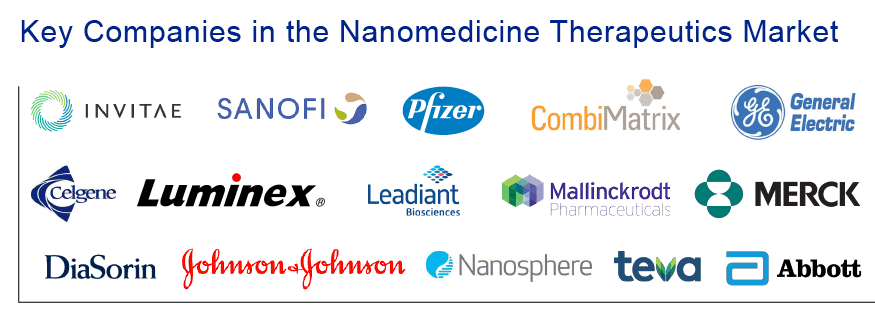How is Nanomedicine Transforming the Dynamics of the Healthcare Industry?
Jun 22, 2022
Table of Contents
Over the span of the last decade, new and revolutionary technology has been introduced into our daily lives – nanotechnology. It has been applied in multiple fields through an integrated approach. With a rise in the number of applications and products containing nanomaterials, nanotechnology now is a very integral part of pharmaceutical research for the development of new medicines. Nanotechnology has been found to be capable of providing a new and innovative medical solution to address unmet medical needs in the form of nanomedicine.
Nanomedicine is the term used for the application of nanotechnology for medical purposes, here nanomaterials are utilized for the diagnosis, monitoring, control, prevention, and treatment of various diseases. Nanomaterials constitute some novel physicochemical properties, that differ from their conventional bulk chemical equivalents, because of their small size. These properties greatly increase a set of opportunities in the field of drug development.
Downloads
Article in PDF
Recent Articles
- Novel Genetics Biomarker found by a Group of Researchers May Offer Novel Treatment Approach for C...
- Cilta-cel Demonstrates Prolonged and Deep Responses across Advanced Treatment Lines, Signifying P...
- HDAC (Histone Deacetylase) Inhibitors – A Promising Anti-Cancer Target
- Snippet
- Assessing the Major Growth and Ongoing Developments in the Clinical Diagnostics Market
Key Applications of Nanomedicine
Nanomedicine is the application of nanotechnology in healthcare applications such as disease treatment and diagnosis employing nanoparticles in medical devices, as well as nanoelectronic biosensors and molecular nanotechnology. Despite numerous challenges, such as a lack of foresight into the toxicity of these technologies and an immature regulatory framework to examine them, the diagnostic and therapeutic potential of nanomedicine should accelerate its development in the coming years. The major applications of nanomedicine in healthcare are
Smart Pills
The term ‘smart pills’ refers to nano-level electronic devices that are formed and designed like pharmaceutical pills but perform more advanced tasks such as sensing, imaging, and drug delivery. Previously, nanotechnology aided in developing smart pills such as the PillCam, a capsule with a miniature video camera, and dose-tracking pills. Smart pills are part of a growing number of technological advances in medical diagnostics, and they can deliver unambiguous answers about GI tract disorders in the least intrusive way possible for the patient.
Smart pills can potentially transform gastrointestinal disease detection and treatment, perhaps replacing traditional diagnostic approaches such as endoscopy/colonoscopy. Smart pills have several applications, but they can be used for sophisticated diagnostic methods and therapies in the case of gastrointestinal diseases. The smart pill can be used to measure critical information about GI symptoms and wirelessly transmit data. Smart pills are currently highly expensive due to the extensive funding, R&D efforts, manufacturing expenses, and workforce. Despite these hurdles, several leading MedTech companies, tech businesses, and startups are working hard to offer low-cost smart pills to the healthcare sector to meet demand and grab market share.
Nanomedicine Cancer Detection and Treatment
The damage caused to the body’s healthy cells during chemotherapy and radiation treatment is a major issue. In treating skin cancer, new nanomedicine technologies are being deployed, which allow for the effective delivery of medicines and other therapeutic therapies to specific tumor locations and target cells with minimal hazardous side effects. Nanomedicine in cancer can be employed as an adjuvant for vaccine therapy or as a drug carrier to help us target tumors more effectively with anti-cancer agents while keeping normal tissues unharmed.
Nanotherapeutics help to overcome conventional cancer chemotherapy’s lack of selectivity, multidrug resistance, and aqueous solubility. Nanomedicine is being used to generate NanoFlares, a new approach for identifying cancer cells in the circulation. NanoFlares are particles that bind to genetic targets in cancer cells and generate light when that specific genetic target is located, assisting in their discovery. The use of nanotechnology-based therapeutic agents reduces patient risk and improves survival rates. The application of nanotechnology in cancer treatment enhanced the prospect of destroying cancer tissues while causing minimal damage to healthy tissue and organs, detecting cancer, and eliminating cancer cells before they form tumors.

Nanomedicine in Drug Delivery
Most nanotechnologies in healthcare involve the use of nanovectors to carry and release an active substance into target cells in a precise manner. This nanoparticle vectorization allows for increased drug efficacy and bioavailability while lowering dose and toxicity. These nano-drugs are increasingly frequently employed in oncology, particularly in treating “hard to access” tumors such as pancreatic, ovarian, and even brain cancer. Nanoparticles are also employed as a heat source to improve the efficacy of cancer radiation, allowing for fewer sessions or lower dosages. For instance, Nanobiotix has developed a technology for aggregating hafnium oxide nanoparticles: when administered before radiotherapy, these particles stick to tumor cells, amplifying X-rays’ potential to precisely destroy them. The start-up received Fast Track approval from the FDA for the study of NBTXR3, a product derived from this technology, in head and neck tumors.
Nanomedicine and Regenerative Medicine
Nanotechnology and Regenerative Medicine are rapidly emerging fields that have the potential to transform modern medicine. Regenerative medicine has developed greatly in recent years with the advent of nanotechnology and promises to be a viable strategy for restoring the function and regeneration of diseased tissues and organs. Regenerative medicine holds the potential to replace damaged tissue with healthy, functional tissue. Biocompatible materials can be designed to look like physiological tissue. These nanobiomaterials can also be coupled with stem cells, acting as scaffolds, providing the proper environment for cells to proliferate, differentiate, and become functional. Currently, the applications range from bone reconstruction to wound healing at the experimental stage.
Challenges of Unmet Medical Needs in Nanomedicine
Humankind is still fighting a slew of serious and complex diseases, including cancer, cardiovascular disease, multiple sclerosis, Alzheimer’s and Parkinson’s disease, diabetes, and several types of significant inflammatory or infectious diseases (e.g., HIV). Most of these diseases have a significant detrimental impact on the patient and society as a whole and the associated social and insurance systems. It is critical to combat these scourges with proper measures, which are substantially handled by nanomedicine applications. Nanomedicine has the potential to bring promising answers to numerous diseases, raising great expectations for millions of people for better, more efficient, and inexpensive healthcare. Nanotechnologies have an impact on practically every aspect of modern medicine, from diagnostics to illness monitoring, surgery and chemotherapy, and regenerative medicine.
Several fields of medical treatment are already benefiting from nanotechnology’s advantages. The first nanotechnology-based targeted medication delivery systems are now on the market, while others are in clinical trials or, in the vast majority of cases, are under development. Diagnostics at the nanoscale is another highly appealing field of nanomedicine, and the goal is to detect the disease as early as possible. Ideally, a single cell exhibiting bad behavior would be recognized and either cured or removed. Because of new regenerative medicine concepts, many patients with organ failure or serious injuries now have hope. Artificial skin, bone, and cartilage are already in advanced stages of research and, in some cases, on the market.
Major Benefits of Nanomedicine
Nanomedicine has very significant importance from a therapeutic perspective. Nanomedicine aims to accomplish valuable insights, innovation, and desired treatment results in healthcare. It has several unique benefits over the conventional drug delivery system. It can effectively be employed for the early detection and prevention of diseases and can enhance the diagnosis, treatment, and follow-up of a wide range of diseases.
Besides cancer, Nanomedicine can provide a better clinical outcome for other groups of diseases such as cardiovascular, neurodegenerative, musculoskeletal, and inflammatory diseases. Nanotherapeutics can reduce toxicity, have greater dose-response (improved drug targeting), and enhance solubility, making them more favorable than conventional medicines.
Nanomedicine can also play a critical role in detecting and diagnosing diseases. Considering the experimental development of nanomedicines in terms of design (structure), surface morphology/topography, biomolecules formulation, nanomedicine active ingredients, and manufacturing, there has been significant growth in the segment over the past few decades. However, there are substantial challenges that hamper the clinical feasibility and the market launch of these products, a very high capital investment being the major one.
Nanomedicine Market Assessment
Over the years, the number of approved nano-based pharmaceutical applications and products has increased at an impressive rate as these nanoparticle-based drugs have several unique benefits and can provide promising results in numerous diseases. Nanomedicine reduces undesirable toxicity, improve patient adherence, enhance efficacy, and provide better clinical results and treatment outcome. These new generations of Nanomedicine can overcome the issue concerning the conventional pharmaceutical agents, including the formulations and their delivery systems.
To tap the market share and to gain an early advantage, pharma and biotech companies are diligently working to develop various novel Nanomedicine technologies and products. Many nanocarrier-based therapies are already available in the market, and hundreds of the therapies are in the different stages of the clinical trials and are anticipated to hit the market in near future. The launch of the therapies is expected to improve the treatment scenario and health outcome.
Since 1989, around 78 nanomedicines products have been approved, and several of these nanomedicines are in the global healthcare market. FDA has approved over 66 products. Similarly, the European Medicines Agency (EMA) has approved 31 products. The products approved range from nano-delivery and pharmaceutical to medical imaging, diagnostics, and biomaterials.
The government support for pharma and biotech companies has stimulated the Nanomedicine market growth to a much larger extent. Like, the FDA has approved several Investigational New Drug (IND) applications for nano-formulations. The positive approach by the health organization has also enabled clinical trials for major indications such as lymphoma, breast cancer, lung cancer, mesenchymal tissue, central nervous system, solid tumors, and genitourinary cancer, among others.

Globally, major pharma and biotech giants such as Invitae Corporation, Sanofi, Pfizer, CombiMatrix Corporation, Celgene Corporation, Luminex Corporation, Leadient BioSciences, Mallinckrodt, DiaSorin, Johnson & Johnson, Nanosphere, General Electric Company, Merck, Pfizer, Teva Pharmaceuticals, Abbott Laboratories, among others, are actively operating in the Nanomedicine Market. The rising prevalence of various chronic diseases, growing awareness regarding nanomedicine, the advancement in R&D activities, increase in investment, growing healthcare expenditure, and a rise in collaboration between healthcare institutions and pharma companies, will also stimulate the Nanomedicine Market growth in the upcoming years. The advancement and a greater understanding of genetics, proteomics, molecular and cellular biology, material science, and bioengineering will also propel the Nanomedicine Market growth.
Nanomedicine Future Prospects
Through the course of years, several applications of nanomedicine have been implemented in clinical practice, which ranges from medical devices to nanopharmaceuticals. Although there is still a long path to the complete regulation of nanomedicines, from the creation to the development of protocols for evaluation, characterization, and process control of nanomedicines, the reformulation of already existing medicines and the development of new ones has been largely boosted throughout the research of nanomedicine. Nanomedicine products span a large range in terms of structure and type and have been incorporated into a multitude of indications for acute as well as chronic diseases.
The ongoing research of nanomedicine is rapidly leading to the rise of more sophisticated nanostructured designs that needs a careful understanding of the pharmacodynamic and pharmacokinetic properties of nanomedicines. In the coming years, with the advent of innovation in science and technology, it is anticipated that a higher number of medicines based on nanotechnology will be formulated. The development and evolution of nanomedicines will very much impact the pharmaceutical market. And this addition shall be carried out in harmony to support rational decisions made with respect to the Nanomedicine market.
Downloads
Article in PDF



